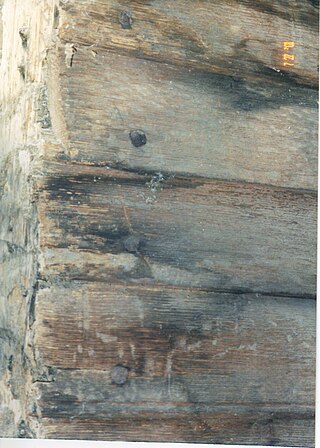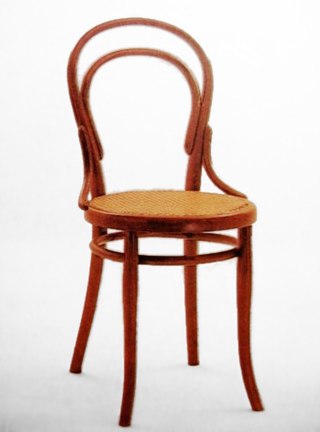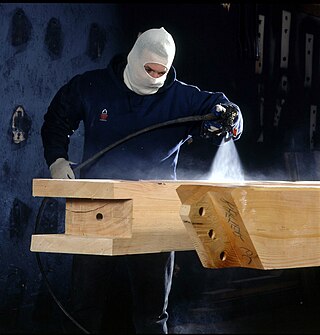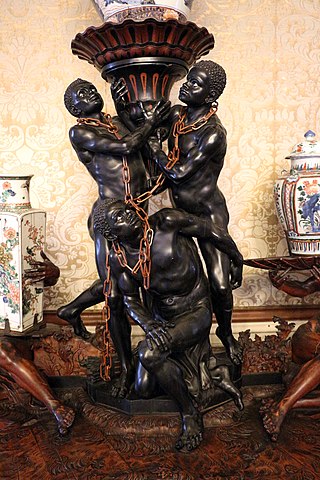Ebonising is a process for darkening wood, giving it an appearance similar to ebony, hence the name.
Ebonising is a process for darkening wood, giving it an appearance similar to ebony, hence the name.
While little record exists of who invented ebonizing, it was popular among the upper classes throughout the Early Modern period, especially when ebony was scarce. In the 19th century, ebonizing became popular as ebony was no longer nearly plentiful enough to feed demand for the new mass market furniture. [1]
One process uses iron dissolved in vinegar as the darkening agent. The ferric acetate thus formed reacts with the tannin in the wood, forming a black substance crusting the top of the wood. [2] [3] Since hardwoods have higher tannin content, they are more convenient woods to ebonize. However, softwoods can be ebonized by soaking them with tea (which has a high tannin content) and then applying the solution. [3]

Woodworking is the skill of making items from wood, and includes cabinetry, furniture making, wood carving, joinery, carpentry, and woodturning.

Tannins are a class of astringent, polyphenolic biomolecules that bind to and precipitate proteins and various other organic compounds including amino acids and alkaloids.

Joinery is a part of woodworking that involves joining pieces of wood, engineered lumber, or synthetic substitutes, to produce more complex items. Some woodworking joints employ mechanical fasteners, bindings, or adhesives, while others use only wood elements.

The Eastlake movement was a nineteenth-century architectural and household design reform movement started by British architect and writer Charles Eastlake (1836–1906). The movement is generally considered part of the late Victorian period in terms of broad antique furniture designations. In architecture the Eastlake style or Eastlake architecture is part of the Queen Anne style of Victorian architecture.

Particle board, also known as particleboard, chipboard, and low-density fiberboard, is an engineered wood product manufactured from wood chips and a synthetic resin or other suitable binder, which is pressed and extruded. Particle board is often confused with oriented strand board, a different type of fiberboard that uses machined wood flakes and offers more strength.

Clapboard, also called bevel siding, lap siding, and weatherboard, with regional variation in the definition of those terms, is wooden siding of a building in the form of horizontal boards, often overlapping.

Bentwood objects are those made by wetting wood, then bending it and letting it harden into curved shapes and patterns.

Wood finishing refers to the process of refining or protecting a wooden surface, especially in the production of furniture where typically it represents between 5 and 30% of manufacturing costs.

In woodworking, veneer refers to thin slices of wood and sometimes bark that typically are glued onto core panels to produce flat panels such as doors, tops and panels for cabinets, parquet floors and parts of furniture. They are also used in marquetry. Plywood consists of three or more layers of veneer. Normally, each is glued with its grain at right angles to adjacent layers for strength. Veneer beading is a thin layer of decorative edging placed around objects, such as jewelry boxes. Veneer is also used to replace decorative papers in wood veneer HPL.

Andrea Brustolon was an Italian sculptor in wood. He is known for his furnishings in the Baroque style and devotional sculptures.
Bog-wood, also known as abonos and, especially amongst pipe smokers, as morta, is a material from trees that have been buried in peat bogs and preserved from decay by the acidic and anaerobic bog conditions, sometimes for hundreds or even thousands of years. The wood is usually stained brown by tannins dissolved in the acidic water. Bog-wood represents the early stages in the fossilisation of wood, with further stages ultimately forming jet, lignite and coal over a period of many millions of years. Bog-wood may come from any tree species naturally growing near or in bogs, including oak, pine (Pinus), yew (Taxus), swamp cypress (Taxodium) and kauri (Agathis). Bog-wood is often removed from fields and placed in clearance cairns. It is a rare form of timber that is claimed to be "comparable to some of the world's most expensive tropical hardwoods".

Amish furniture is furniture manufactured by the Amish, primarily of Pennsylvania, Indiana, and Ohio. It is generally known as being made completely out of wood, usually without particle board or laminate. The styles most often used by the Amish woodworkers are generally more traditional in nature.

Heat bending is the procedure of bending wood into different curves and shapes using moisture and a bending iron. By placing the wood into water, the moisture and heat from the bending iron will reform the structure of the wood, reorganizing the fibers of the wood to prevent the wood from springing back to its original state. This process is usually used for woodworking, as well as making the sides or "ribs" for stringed musical instruments.

Steam bending is a woodworking technique where wood is exposed to steam to make it pliable. Heat and moisture from steam can soften wood fibres enough so they can be bent and stretched, and when cooled down they will hold their new shape.
Anigre is an African hardwood commonly used for plywood, interior furniture, cabinetry, and high-end millwork applications. It is frequently sliced and sold as veneer, although it is available in board form as well. In board form it is used for boat building, general carpentry, and other light construction uses.

A cabinet is a case or cupboard with shelves and/or drawers for storing or displaying items. Some cabinets are stand alone while others are built in to a wall or are attached to it like a medicine cabinet. Cabinets are typically made of wood, coated steel, or synthetic materials. Commercial grade cabinets usually have a melamine-particleboard substrate and are covered in a high pressure decorative laminate, commonly referred to as Wilsonart or Formica.

Ammonia fuming is a wood finishing process that darkens wood and brings out the grain pattern. It consists of exposing the wood to fumes from a strong aqueous solution of ammonium hydroxide which reacts with the tannins in the wood. The process works best on white oak because of the high tannin content of this wood. Fumed oak is also called fumigated oak or smoked oak. Other species may also be fumed, but usually will not darken as much as white oak. In America, the introduction of the process is usually associated with the furniture maker Gustav Stickley at the beginning of the 20th century, but fuming was known in Europe before this.

Adrien Segal is an artist, furniture maker, and sculptor who uses data to inform her artwork. She is currently an adjunct professor of Furniture Design at the California College of the Arts and a practicing artist studio furniture maker.

What later came to be known as the William and Mary style is a furniture design common from 1700 to 1725 in the Netherlands, Kingdom of England, Kingdom of Scotland and Kingdom of Ireland, and later in England's American colonies. It was a transitional style between Mannerist furniture and Queen Anne furniture. Sturdy, emphasizing both straight lines and curves, and featuring elaborate carving and woodturning, the style was one of the first to imitate Asian design elements such as japanning.
Aspen Golann is an American woodworker who produces furniture.